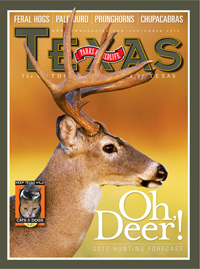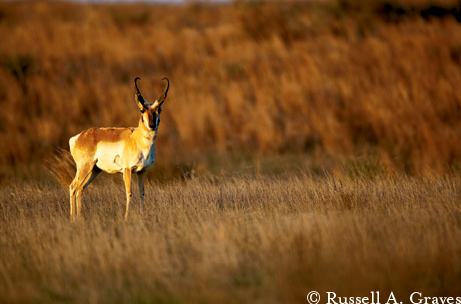
The Pronghorn Prognosis
These fleet plains animals have been hit by sharp declines in numbers, and biologists are on the lookout for a culprit.
By Steve Lightfoot
Pronghorn antelope use vision and speed to elude predators, but in recent years have been unable to outrun an unseen enemy that has contributed to alarming population declines in Texas. Since estimates of about 17,000 animals in the Trans-Pecos region in 1987, Texas Parks and Wildlife Department biologists say pronghorn numbers have continued to plummet, with this majestic plains animal now numbering about 5,000 in that region.
“Pronghorn are a unique and iconic species of our native grasslands; their presence symbolizes healthy grassland ecosystems and perseverance,” says Shawn Gray, TPWD pronghorn program leader.

Pronghorns — the fastest land animals in North America — once ranged the prairies and deserts west of the Mississippi River and across the Rocky Mountains, from southern Canada to central Mexico. Original numbers are estimated to be between 30 million and 40 million animals. Pronghorns historically occurred over most of Texas, but because of habitat loss and overharvest during the late 1800s and early 1900s, populations plummeted.
Through the conservation actions of Texas landowners, and protective measures implemented by the Game, Fish and Oyster Commission (the predecessor of TPWD), populations rebounded during the 1960s, ’70s and ’80s. Today, Texas pronghorn populations are found in the Trans-Pecos, Panhandle, western Edwards Plateau and southern Rolling Plains ecoregions. In 2009, the statewide population estimate was about 18,000 pronghorn. The Panhandle region supports the largest populations, followed by the Trans-Pecos, Rolling Plains and Edwards Plateau.
Drought during the 1990s seriously affected pronghorns, and numbers in the Trans-Pecos declined to an all-time low of 5,000 in 2001. However, pronghorns rebounded in the last decade thanks to increased rainfall, and had doubled in population by 2007. But that recovery was short-lived. An extended drought, heightened predation and a late hard freeze resulted in a loss of an estimated 2,000 antelope in the Marfa Plateau alone.
Even after range conditions improved, ranchers continued to see die-offs of adult pronghorns and poor fawn survival in the Marfa Plateau (9 percent in 2009 and 5 percent in 2010).

Wildlife officials are investigating the causes for the continued decline, and concerns about the future health of pronghorns in the Trans-Pecos are growing among landowners and sportsmen. Pronghorns have historically managed to withstand predation, weather and habitat changes, but there is no shortage of threats.
As the pronghorn numbers declined, TPWD reduced pronghorn hunting permits. Only 569 buck permits were issued in the Trans-Pecos last year, with an average utilization rate of 30 to 40 percent. Since regulated hunting began, data indicates such mortality is not a factor in the pronghorn population declines. In addition, research suggests that timely, regulated hunting will have no impact on pronghorn population growth. Typically, weather, natural predation and land use practices play a larger role.
“When population trends didn’t correlate with good range conditions in the Trans-Pecos, we started looking in other areas,” Gray says.
Mounting concerns spurred creation of the Trans-Pecos Pronghorn Working Group, a team of pronghorn stakeholders that includes West Texas landowners, outfitters, TPWD biologists, Borderlands Research Institute personnel and wildlife veterinarians. The group decided that research into potential environmental effects would be a priority, and biologists began focusing investigative efforts on identifying disease possibilities.
“We conducted necropsies on hunter-harvested pronghorn in 2009 and discovered elevated levels of barber’s pole worms,” Gray noted.
Barber’s pole worms (Haemonchus sp.) have been known to affect domestic sheep and goat populations, according to Gray, but very little research has been done on the parasite’s effects on pronghorn.

“We collected samples from 102 pronghorn from 50 ranches throughout the Trans-Pecos ecoregion,” Gray says. “We tested copper and selenium levels, since these minerals can be related to reproduction. We found that mineral concentrations were below normal for most ruminants. Some copper levels that were recorded were very low, and this could be tied to high parasite concentrations.”
Gray says copper levels are important for reproduction, but how they affect pronghorn reproduction isn’t clear. Biologists do know that pronghorn that have elevated copper levels are healthier and reproduce in greater numbers.
“We also looked for internal parasites within fecal samples and abomasums, or the true stomach that’s present in ruminants,” he added. “Of 89 abomasums analyzed, only four did not contain bloodworms. The average bloodworm total for all abomasums sampled was 552, and the highest number counted in a single abomasum was 4,080.”
Biologists also sampled 17 pronghorn in the Panhandle for comparison. Perhaps most alarming in the initial sampling results was that the levels of bloodworms in Trans-Pecos samples were six times those of samples taken in the Panhandle.
“We do know that numbers above 2,000 per animal can affect health and survival in sheep and goats,” explains Billy Tarrant, TPWD district leader for the Trans-Pecos.
“Pronghorn managers understand the importance of our traditional recognized limiting factors such as precipitation, habitat quality and quantity, barriers to movement and predation. This parasite appears to be an additional factor affecting population dynamics of pronghorn in the Trans-Pecos.”
However, relationships between parasite loads, climate and habitat are not well-understood. Similarly, the effects of pronghorn movements and distribution on parasite numbers are not clear, and additional sampling and research are needed.
“These high numbers of bloodworms may be symptomatic of something that is missing in the habitat or changes in the climate,” says Tarrant. “Even if it’s not, there may be accepted habitat management practices that can help mitigate these losses. At this point we really don’t know, and more research and surveillance is definitely needed to figure that out.”
This fall, Texas Parks and Wildlife Department biologists, Range and Wildlife Club students from Sul Ross State University and cooperating landowners will be analyzing more samples extracted from hunter-harvested pronghorn in West Texas.
Other states have expressed interest in the Texas findings, and, in fact, Arizona and New Mexico have indicated that they plan to conduct sampling for internal parasites.
TPWD also plans to conduct sampling of other wildlife to determine if Haemonchus is infecting other ruminants, but in samples taken from a small number of mule deer throughout the Trans-Pecos, virtually no Haemonchus has been found so far.
Because the barber’s pole worm has posed a threat to sheep and goats, biologists are also working with researchers in Georgia to analyze the DNA of worms that infected pronghorns to determine if it is the same strain as that found in sheep and goats or a separate strain unique to pronghorns.
“Pronghorn have survived thousands of years with predators, climate changes and humans; however, their need to inhabit open country with varying successional stages (mainly caused by fire) has not changed,” Gray says. “I am optimistic that by conducting more research on the interaction between barber’s pole worms and pronghorn, we will learn more about Haemonchus’ influence on pronghorn survival, minimizing worm infestations and increasing habitat quality to improve pronghorn nutrition.”

